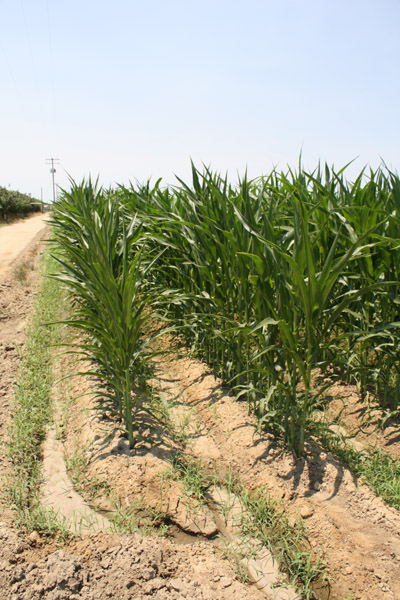 The Tulare Irrigation District held its board of directors meeting on Tuesday, October 12, 2021, remotely on Zoom. The board met at its headquarters with Chairman Dave Bixler calling the meeting at about 9:00am. TID General Manager Aaron Fukuda informed the public the board met in open session at 8:45am to pass the resolution needed to hold remote meetings for one more month.
The Tulare Irrigation District held its board of directors meeting on Tuesday, October 12, 2021, remotely on Zoom. The board met at its headquarters with Chairman Dave Bixler calling the meeting at about 9:00am. TID General Manager Aaron Fukuda informed the public the board met in open session at 8:45am to pass the resolution needed to hold remote meetings for one more month.
The Meeting
Water Master Marco Crenshaw showed the board storage at Lak e Kaweah and it is low, very low. Crenshaw has been following ocean temperatures in the Pacific and there is a hot blob floating around which can impact weather patterns. He also showed a map of the major fire burning in the Sierra Nevada in the Kaweah River watershed. There was a good rain came through last Friday and I believe it helped the fire situation. The thick smoke settling on the Valley floor has been gone but yesterday was windy, up to 23-miles per hour. That cleared the air but may have fanned remaining flames as well.
e Kaweah and it is low, very low. Crenshaw has been following ocean temperatures in the Pacific and there is a hot blob floating around which can impact weather patterns. He also showed a map of the major fire burning in the Sierra Nevada in the Kaweah River watershed. There was a good rain came through last Friday and I believe it helped the fire situation. The thick smoke settling on the Valley floor has been gone but yesterday was windy, up to 23-miles per hour. That cleared the air but may have fanned remaining flames as well.
Fukuda said there needs to be a visit with the water treatment plant operators at the Cities of Tulare and Visalia. He said when he and former GM Paul Hendrix negotiated the agreement to yield water to TID the 2014-2015 drought kicked in. Since then they’re seeing room for some operational improvements.
Fukuda also reported on a presentation on the State Water Project. TID is on the Kaweah River and the Friant Division of the federal Central Valley Project but the State Water Project and the CVP share many facilities and the same hydrology. He said he heard from a Department of Water Resources speaker who talked about the impacts of fires on watersheds. The recent Creek Fire in the San Joaquin River watershed was presented as an example. He said to expect more debris inflows on the Kaweah as the mountains are steeper than on the San Joaquin River watershed. The DWR person said California has a long way to go to recover from the 2020-2021 drought. He said let it rain, we need a wet year but the allocations will reflect a dry year. Carryover will be questioned but it will take 140 percent wet year to make up for this year and just get to normal storage. The channel loss and evaporation will be much higher.
The audio got pretty bad for a bit but I did hear Fukuda say NCWA is counterbalancing the very poor reporting on salmon populations. The lamestream was reporting a big fish kill and the folks on the ground said not so.
Fukuda also said the Colorado River supplies were discussed. Geoff Vanden Heuvel, a former Southern California dairy farmer said the Colorado River is salty and most of it goes to San Diego. He said the Delta water is the higher quality water for So Cal. He also said California is at the apex of the pecking order for Colorado River supplies. But the conveyance project in Arizona has placed the California claim in a less secure position. There’s a lot happening on the Colorado River and it doesn’t get much coverage here in the Valley. Vanden Heuvel said Metropolitan WD controls a big chunk of Palo Verde WD and there are many folks farming in that district worried about Met’s chairman having such power over the supplies. PVWD has an old and somewhat unique water right evidently, I think I heard at least 100,000 a/f of the Colorado supply goes there first.
conveyance project in Arizona has placed the California claim in a less secure position. There’s a lot happening on the Colorado River and it doesn’t get much coverage here in the Valley. Vanden Heuvel said Metropolitan WD controls a big chunk of Palo Verde WD and there are many folks farming in that district worried about Met’s chairman having such power over the supplies. PVWD has an old and somewhat unique water right evidently, I think I heard at least 100,000 a/f of the Colorado supply goes there first.
O&M/Finance Reports
Superintendent Wayne Fox gave the board and update on what’s happening in the field. TID is usually pretty aggressive with its operations and maintenance. If they need a specialized piece of equipment and can’t find it reasonably priced and sometimes can’t find it at all – they make their own. They have a spray rig designed and fabricated in-house. Fox reported on the usual downtime maintenance such as replacing bad pipe, clearing channels and repairing gates and turnouts. Fukuda said the district is changing. When most of the crop was cotton everything was gravity fed ditches. Now there is more and more pressurized pipes and that seems to be the trend, although it does make things more complicated.
Fox reported on the usual downtime maintenance such as replacing bad pipe, clearing channels and repairing gates and turnouts. Fukuda said the district is changing. When most of the crop was cotton everything was gravity fed ditches. Now there is more and more pressurized pipes and that seems to be the trend, although it does make things more complicated.
Controller Kathi Artis gave the financial reports and presented the board with the bills to be paid. The board agreed to pay the district’s bills. Something interesting. Fukuda said a consultant requested the payments be made to a special account and the district almost did. But after checking found out it was a scam just in time. Something else, TID pays for certain employees’ safety boots. That costs more than $700. Fukuda said he missed the World Ag Expo where he gets his safety boot discount. Another thing, the cost of legal advertising. I’m trying to get WaterWrights.net adjudicated to receive legal ads but I’m not holding my breath. Artis also gave an audit update.
Engineering
The engineering report was next and Jeremy Barroll reported there is a gas pipeline going in at 4 Creeks Dairy and he’s asked or very clear plans for canal crossings. The district got a $1.14 million grant from the feds. Looks like the district will get some variable frequency drive pumps and new turnouts and meters. This project will use Provost & Pritchard to conduct surveying and environmental permitting. The project should be completed by September 2024. There are still questions about design and this will be Barroll’s first big project. Good for him. He’s a good guy. He came by my place once to be a part of my annual party but it was the wrong day. So we went to the Fresno Fair instead. He was fun to hang out with. He reminds me of Fred Armisen. Also, the timeline to spend the grant money is tight so a contractor will be hired to install things.
September 2024. There are still questions about design and this will be Barroll’s first big project. Good for him. He’s a good guy. He came by my place once to be a part of my annual party but it was the wrong day. So we went to the Fresno Fair instead. He was fun to hang out with. He reminds me of Fred Armisen. Also, the timeline to spend the grant money is tight so a contractor will be hired to install things.
There is an Area 18 somewhere in TID. P&P has given a quote to complete the CEQA and NEPA permitting for the modernization project. I’m not sure what Area 18 is. I know I’m not the only one with visions of alien autopsies. Wouldn’t that be something? Somewhere in TID a UFO lands. Big Foot and Elvis step out with a new diet that will cure cancer and cause you to lose 10 pounds a day. Welcome to Area 18.
SGMA
Fukuda gave a Kaweah Subbasin update saying everyone is waiting to see how the GSPs score. The decision of accepting pumping allocations hasn’t been fully decided throughout the entire subbasin.
Fukuda said there is now data from Land IQ dating back to October 2020. That’s a good enough chunk of data to determine things. James Fisher is a new engineer working at TID. He said the district is pumping about 3.3 a/f per acre and is overall 80 percent efficient. Using Land IQ the GSA can determine ET and other data from the ground truthing stations.
Fukuda thanked Vanden Heuvel for sharing one of his Milk Producers Council newsletters that showed Land IQ findings from Lower Tule River and Pixley IDs. There was a chart showing those districts’ total acres, a/f per acre and weighted average ET by crop type ranging from almonds to wheat. Double cropping can yield up to five a/f of over pumping. There was a typo Director Dave Martin pointed out in the chart. It showed 55 acres of cheeries planted and he wanted to know if that’s how they make Cheerios. The most acreage planted is corn with 19,226 acre and olives only have one acre. Director Rick Borges pointed out all the information is given in inches and feet but for precipitation that is given in millimeters. That is confusing.
that showed Land IQ findings from Lower Tule River and Pixley IDs. There was a chart showing those districts’ total acres, a/f per acre and weighted average ET by crop type ranging from almonds to wheat. Double cropping can yield up to five a/f of over pumping. There was a typo Director Dave Martin pointed out in the chart. It showed 55 acres of cheeries planted and he wanted to know if that’s how they make Cheerios. The most acreage planted is corn with 19,226 acre and olives only have one acre. Director Rick Borges pointed out all the information is given in inches and feet but for precipitation that is given in millimeters. That is confusing.
Next Fukuda, who is also GM of the Mid Kaweah GSA gave the board an update on the groundwater allocation and pumping cap proposal, version eight. Director Martin is also the Chair of the MKGSA. Fukuda said the monitoring network showed only two out of 34 wells are on track with the GSP. He said growers are not calling in angry, they just want to know where they stand and are asking for as much flexibility as possible. Growers know there has to be a minimum threshold or only the last one standing will be able to farm.
groundwater allocation and pumping cap proposal, version eight. Director Martin is also the Chair of the MKGSA. Fukuda said the monitoring network showed only two out of 34 wells are on track with the GSP. He said growers are not calling in angry, they just want to know where they stand and are asking for as much flexibility as possible. Growers know there has to be a minimum threshold or only the last one standing will be able to farm.
Fukuda said the water accounting system is on hold until the native groundwater allocation and pumping cap is adopted. So far 10-inches per acre is the negotiated number. Each GSA can determine how it wants to allocate this amount. He stressed this is an emergency plan and it needs to be adopted by the entire subbasin, as provided by the coordination agreement, to be successful. Fukuda also stressed the need for user input.
The water accounting framework is being developed and although MKGSA is putting in more water than it’s pumping out the measurements show groundwater levels dropping. That is due to underground flow into other GSAs.
The native yield bucket is evenly distributed between all parties in the subbasin. That number is 10-inches and the average in the Valley is 6-inches. There are 6,000 acres of white area in the GSA. Martin reported if the city can’t provide water in its sphere of influence you can drill a well. Someone purchased some land it can’t develop for residential or business use at this time and put in pistachios. So a well was drilled. This looks like an effort to sneak in a well. It will be six years at best before those trees begin producing and since there is now a water source on the property with the new well those trees will be ripped out and that land will be built on before one nut is harvested.
The cap plan has two tiers for relief pumping. The first tier won’t allow groundwater transfers. Tier two can allow moving water one to five miles. Durability of groundwater means how long you can use the allocation – it’s carryover. But the proposed plan will limit carryover to five years and the first in and first out rule will apply to groundwater. Each year you carryover the water there is some percentage lost to leave behind. All the water banks in California require some leave behind, usually 10 percent. Also, ET doesn’t equal pumping.
Disadvantaged communities and rural domestic wells are figured in on this also. Part of the goal of the MKGSA GSP is to retain the ability to grow with the general plan. Fukuda said the city managers realize there is a problem and are willing to work. He said the cities need to get groundwater under them as soon as they can.
TID uses a surface water tracking system called STORM. It’s a custom water accounting and billing system used for water allocation, tracking and invoicing. Fukuda has been speaking with the STORM developer and asked for a mirror image of the surface water and make it groundwater. This has good potential and the developer is interested and it could save MKGSA some money. This can also be utilized with the Irrigated Lands Program.
Fukuda said due to the dry year this has to be developed soon, 2022 at the latest. He said TID growers don’t like this. They won’t cheer for it, but they won’t fight it and he’s grateful for their willingness to pursue. He said the GSA and the growers are learning from each other as this goes along. He didn’t want to see mistakes end up causing a chain reaction that create disasters for growers in the following years. He sees Spring 2022 as the best start date and there shouldn’t be any retroactive pumping cap. He also wants to see this be more of a carrot than a stick. If incentives can be in place to reduce planting or other water saving measures, that would be better than imposing fines. This plan will also depend on grower honesty and trust.

The penalty concept is important to keep flexible. The original proposal was if someone over pumps they lose a one to one amount next year and are fined $500 per acre foot. This has been rethought and there are alternatives on the table. One would be to fine the water and not the cash and the other to fine the cash and not the water.
The bottom line for Fukuda is working with others in the subbasin. He said East Kaweah GSA is working on a plan and implementation. He said the Greater Kaweah GSA has made a commitment to implement next year to allow preparation time for the growers. He said that is a difficult decision as is choosing not to implement. He said the MKGSA advisory committee has been advised and a lot of good feedback has come out of this. Martin said attorney Valerie Kincade needs to prepare a presentation to the other GSAs and the cities about what happens if anyone drags their feet. Fukuda said the brakes have to be pumped now to prevent a bad scenario from coming about. He also said we can’t do this on the backs of white area growers. There’s a way everyone can farm.
presentation to the other GSAs and the cities about what happens if anyone drags their feet. Fukuda said the brakes have to be pumped now to prevent a bad scenario from coming about. He also said we can’t do this on the backs of white area growers. There’s a way everyone can farm.
Also the MKGSA needs help. Both Fukuda and Fisher have been working a great deal of overtime on SGMA. Fukuda strongly suggested taking on interns from College of Sequoia’s Ag Irrigation Academy, if I understood correctly. There is a great deal of data input and without interns some of the tasks will have to go to consultants at a higher cost.
Friant
Brosamer & Wall/Tutor Perini have been awarded the Friant Kern Canal a $177 million cost. Fukuda said Brosamer & Wall is one of the finest contractors out there and Tutor Perini is one of the worst. Tutor Perini is also a High Speed Rail contractor. Who do they know to get these lucrative gigs? He said they are mired in a history of litigation, cost overruns and even on the job deaths. The City of Fresno sued to get out of having to pay its $2.6 million share of the repair costs but pulled that suit quicker than a jackrabbit when it found out it could lose its water supply. The US Bureau of Reclamation has completely sided with Friant.
Fukuda said the San Luis Delta Mendota Water Authority is a somewhat complex expense to Friant. Panoche WD sued SLDMWA for $1 million for water accounting and won. Friant Water Authority will be having a board retreat next month.
GM Report
The Collaborative Action Plan continues to pull together some of the diverse interest in water. Fukuda said he’s met with Audubon Society and has been impressed with the willingness to cooperate and coordinate. Having an improved habitat component could improve the chances of better Bureau grant funding. There is an idea of installing an island for the birds in one of TID’s recharge ponds.
Okieville is looking to drill a new shallow well and install a new storage tank. They are having difficulty finding the proper footprint but are having a difficult time finding a location. Fukuda suggested allowing this in a reconfigured TID basin. This is another approach to limiting deep aquifer subsidence.
Action Items
There were two resolutions. Number 21-10 was an approval for levy and collection of assessments for 2022. Absolutely nothing has changed since last year and getting unanimous board approval was a slam dunk. The next resolution, Number 21-11 was similar. Approval for fixing and collecting Central Valley Project environmental charges for 2022. It was also a routine, annual action item and was approved unanimously.
Board Member Reports
I have it on excellent authority all the board member reports were short and boring. That just left closed session so I bugged out at 12:20pm and that was that.
DISCLAIMER OF RESPONSIBILITY; Waterwrights strives to provide clients with the most complete, up-to-date, and accurate information available. Nevertheless, Waterwrights does not serve as a guarantor of the accuracy or completeness of the information provided, and specifically disclaims any and all responsibility for information that is not accurate, up-to-date, or complete. Waterwrights’ clients therefore rely on the accuracy, completeness and timeliness of information from Waterwrights entirely at their own risk. The opinions expressed in this report are those of the author and do not represent any advertisers or third parties.
ALL RIGHTS RESERVED. Copyright 2021 by WaterWrights.net/DAW
TULARE IRRIGATION DISTRICT
6826 Ave 240, Tulare, CA 93274 Office: 559/686-3425
Board: David G. Bixler- President, Richard S. Borges, Jr.-Vice President, Scott Rogers, Dave Martin & Michael Thomas
Staff: Aaron Fukuda-General Manager, Jeremy Barroll-Engineer, Kathi Artis–District Controller, Wayne Fox–Superintendent, Marco Crenshaw–District Watermaster & Alex Peltzer-Attorney.
About: The Tulare Irrigation District was organized September 21, 1889. The original proposal for the formation of an irrigation district covering 219,000 acres, extending from the Sierra Nevada foothills to Tulare Lake, was eventually reduced to 32,500 acres. The District continued in this status until January of 1948 when the so-called Kaweah Lands” (approximately 11,000 acres) were annexed. In October of 1948, approximately 31,000 acres, compromising the area served by the Packwood Canal Company were annexed to the District. A U.S. Bureau of Reclamation contract was signed in 1950 providing an annual supply of 30,000 acre-feet of Class 1 water, and up to 141,000 acre-feet of Class 2 water from the Friant-Kern Canal. The District and the Kaweah Delta Water Conservation District have coordinated efforts to enhance the recharge of groundwater within the Kaweah Basin. During high flow times KDWCD may use the recharge basins with the District for recharge purposes. Further, KDWCD has historically provided for a financial incentive program through which the District sustains the level of groundwater recharge from supply sources into the District. This historical program was recently reinstated by both districts in lieu of the District’s plans to concrete-line this canal to conserve the surface water. TID is a member of the Mid Kaweah GSA DWR#-5-022.11
































